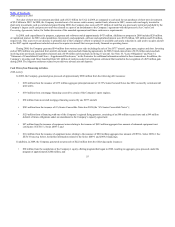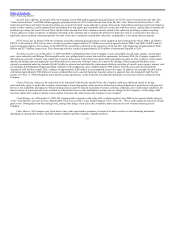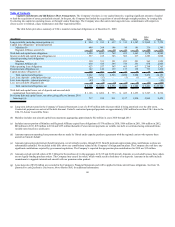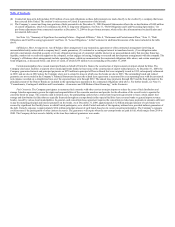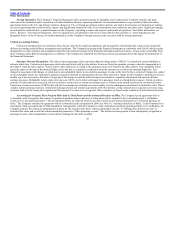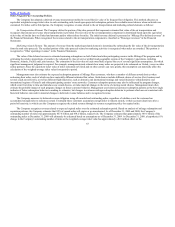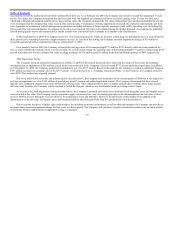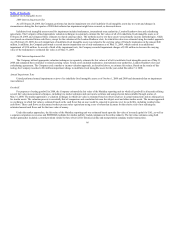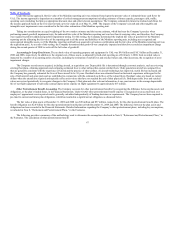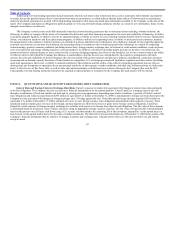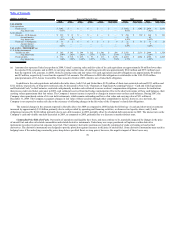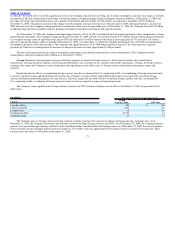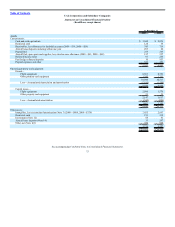United Airlines 2009 Annual Report Download - page 69
Download and view the complete annual report
Please find page 69 of the 2009 United Airlines annual report below. You can navigate through the pages in the report by either clicking on the pages listed below, or by using the keyword search tool below to find specific information within the annual report.
Table of Contents
exceeded the sum of the undiscounted cash flows attributable to their use. As of February 28, 2009, the Company also tested its aircraft for impairment. For all
but two fleet types, the Company determined that the fleet types were not impaired as estimated cash flows exceeded carrying value. For the two fleet types
which had estimated undiscounted cash flows less than carrying value, the Company estimated the fair value of these fleet types and determined that the aircraft
were not impaired as the estimated fair value exceeded the carrying value. For purposes of testing impairment of aircraft, the estimated undiscounted cash flows
were dependent on a number of critical management assumptions including estimates of future capacity, passenger yield, traffic, operating costs (including fuel
prices) and other relevant assumptions. If estimates of fair value were required, fair value was estimated using the market approach. Asset appraisals, published
aircraft pricing guides and recent transactions for similar aircraft were considered by the Company in its market value determination.
In the fourth quarter of 2009, the Company tested five of its owned regional jets, which are leased to a third party, for impairment due to a weak market for
these aircraft and a remaining lease term of approximately one year. As a result of this testing, the Company recorded impairment charges of $19 million to
record the regional aircraft at estimated fair value as of December 31, 2009.
On a quarterly basis in 2009, the Company reviewed the carrying values of its nonoperating B737 and five B747 aircraft, which are being marketed for
sale, to assess whether the carrying values were recoverable. As a result of this testing, the carrying value of the nonoperating B737s and five nonoperating B747
aircraft was reduced to a lower estimated fair value resulting in charges of $19 million and $55 million in the third and fourth quarters of 2009, respectively.
2008 Impairment Testing
The Company tested all aircraft for impairment as of May 31, 2008 for the reasons discussed above. Based on the results of these tests, the Company
determined that an impairment of $38 million existed which was attributable to the Company’s fleet of owned B737 aircraft and related spare parts. In addition,
as of December 31, 2008, the Company performed an impairment test of its B737 aircraft. Based on this analysis, the Company recorded an additional charge of
$107 million to reduce the carrying value of the B737 aircraft. As described in Note 2, “Company Operational Plans,” in the Footnotes, the Company retired its
entire B737 fleet earlier than originally planned.
Due to the unfavorable economic and industry factors described above, the Company also determined in the second quarter of 2008 that it was required to
perform an impairment test of its $105 million of pre-delivery aircraft deposits and related capitalized interest. The Company determined that these aircraft
deposits were completely impaired and wrote off their full carrying value. The Company believes that it is highly unlikely that it will take these future aircraft
deliveries and, therefore, the Company will be required to forfeit the deposits, which are not transferable based on existing contract terms.
As a result of the 2008 impairment testing described above, the Company’s goodwill and certain of its indefinite-lived intangible assets and tangible assets
were recorded at fair value. The Company was not required to apply certain new fair value accounting principles to the determination of the fair value of these
assets in 2008 as the new principles were not effective for nonfinancial assets and liabilities. However, the provisions of this standard were applied to the
determination of the fair value of financial assets and financial liabilities that were part of the Step Two goodwill fair value determination.
Due to extreme fuel price volatility, tight credit markets, the uncertain economic environment, as well as other uncertainties, the Company can provide no
assurance that a material impairment charge will not occur in a future period. The Company will continue to monitor circumstances and events in future periods
to determine whether additional asset impairment testing is warranted.
65


